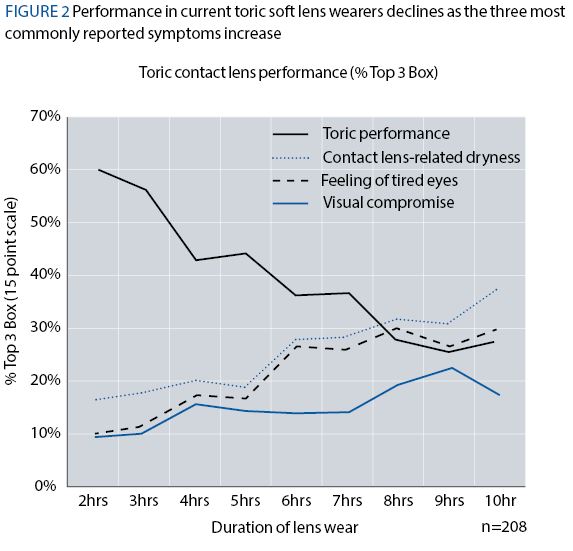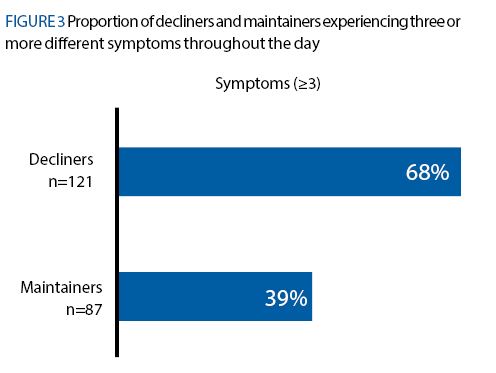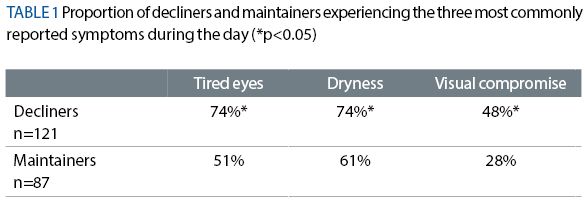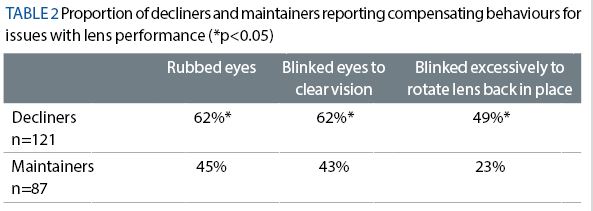New methods of recording soft contact lens performance in real time have led to a better understanding of wearer experience over the course of a day.1,2 Many contact lens wearers experience a decline in performance during the day which is often non-linear and fluctuates considerably.1 Declining comfort is also heavily influenced by changes to the ocular environment.2
These findings have reinforced the need for careful questioning to uncover variability in lens performance. Eye care practitioners should ask whether patients experience symptoms throughout the whole day, and dig deeper into the variety of activities and environments to which patients are exposed.
Although toric soft contact lenses might be expected to show a similar pattern to spherical lenses over a day’s wear, few studies have looked specifically at toric lenses in this way. Optimal lens performance is especially important to astigmats since wearers of toric lenses are more likely than spherical lens wearers to drop out in the first year.3
A study was therefore conducted to map toric contact lens wearer reported performance in real time throughout the day.

Study methodology
Independent market research specialist Kadence International carried out the quantitative longitudinal survey in the US in December 2015 to provide insights into current toric lens performance.4
Existing toric contact lens wearers aged from 18 to 39 years and using their lenses at least four days per week were identified via an online market research panel. They were asked to take short (five-minute) surveys via an app on their smart phones approximately every two hours throughout the course of the day, from lens application to just after removal.
In each survey, participants rated their comfort, vision quality and satisfaction in the past hour on five-point scales. Respondents also selected which activities they had participated in (from a list of 18 such as using a computer or laptop, sitting at an office desk or driving), what indoor or outdoor environments they had been in (from a list of eight, such as being in an air-conditioned environment, being outside on a windy or a dry day), and what symptoms (from a list of 14) they experienced, such as dryness, tiredness and fluctuating vision.
Participants were also questioned about any behaviours they employed to compensate for performance issues that might be relevant to toric lenses, such as rubbing the eyes or changing their blink patterns.
A single ‘performance’ metric on a 15-point scale was calculated from lens comfort, overall vision and overall satisfaction results and compared for time of day, duration of wear, and activities and environments experienced. A ‘vision compromise’ measure combined responses to symptoms of blurriness at far distances, close distances, following lens misplacement/rotation on the eye, when looking in different directions and when changing head positions, as well as fluctuating vision and visual distortion.
Results
A total of 208 current toric contact lens wearers completed the surveys. Of these, 25 were wearing daily disposable lenses and 183 reusable, daily wear lenses (two-weekly or monthly replacement). The mean age was 31.3 years old (range 18 to 39) and 66% were female. Monocular astigmats – patients that were wearing a toric lens in one eye only – comprised 25% of the study sample.
As reported for spherical wearers in the previous study,1 not all current toric contact lens wearers had the same experience. About 42% of those surveyed (‘maintainers’) experienced consistent performance metric throughout the day, while 58% (‘decliners’) experienced a decline, with significant drops in performance at around three to four hours of wear and again at seven to eight hours of wear (figure 1).

Like spherical wearers, toric wearers in the decliner group also showed variable patterns of declining performance: 17% experienced fluctuating performance declines, 24% experienced a continuous decline, 9% experienced a slight decline and 9% experienced a sharp, end of day drop in lens performance.
As the day progressed, incidence of the three symptoms most commonly reported in the study increased as lens performance decreased (figure 2). Toric contact lens performance across the day was negatively correlated with symptoms of contact lens-related dryness (p<0.01), a feeling of tired eyes (p<0.01) and visual compromise (p<0.05).

A higher proportion of decliners than maintainers reported three or more of the listed symptoms throughout the day (66% vs 39%) (figure 3).

Decliners were also more likely to experience the most commonly reported symptoms: tired eyes (74% vs 51%; p<0.05), feeling of dryness (74% vs 61%; p<0.05) and visual compromise (48% vs 28%; p<0.05) (table 1).

Differences were found for the number of activities and environments encountered. Decliners were more likely than maintainers to experience eight or more activities throughout the day or to shift between three or more different environments (figure 4). This was particularly noticeable with digital activities; the more engaged with digital devices the patient was, the faster the rate of performance decline experienced (p<0.05).

Nearly nine in 10 of all respondents (87%) adopted behaviours to compensate for performance issues in at least one way during a day’s wear. Those in the decliner group were more likely than maintainers to try to compensate by rubbing their eyes (p=0.01), blinking hard to clear their vision (p=0.005), and blinking excessively to make the toric lens rotate back into place (p=0.0002) (table 2).

These behaviours are especially relevant to toric contact lens wearers for whom lens orientation and stability are crucial to maintaining clear and consistent vision. Lack of consistency in rotational position and rotational stability are often the primary reasons for patient success or failure with toric soft lenses.4
As we have seen, new wearers of toric lenses are more likely than spherical wearers to drop out, and the main reason for discontinuing is poor vision.3

Conclusions
This study among current toric soft contact lens wearers reveals that nearly six in 10 experience declining performance over the course of a day. A previous study1 has shown a similar pattern of decline for spherical soft lens wearers.
Astigmatic patients who undertake a wider variety of activities, shift between more environments, spend more time using digital devices, report more different symptoms and adopt compensating behaviours are most susceptible to declining lens performance throughout the day. It is therefore important to ask current toric contact lens wearers about their daily activities, as well as probing specific symptoms, to help identify those whose needs are not fully met.
These patients may be excellent candidates for Acuvue Oasys 1-Day with HydraLuxe for Astigmatism Brand Contact Lenses, a new toric soft contact lens designed to offer clear, consistent vision and comfort in challenging environments, soon to be available to eye care practitioners in the UK.
Kieron Mathews is CEO and Ben Daigle an insight manager at independent market research firm Kadence International. Dr Giovanna Olivares is astigmatism platform director, research and development at Johnson & Johnson Vision Care.

References
1 Mathews K, Daigle B, Alford et al. Exploring variability in soft contact lens performance. Optician 2016;251:6546 32-34.
2 Navascues-Cornago M, Morgan PB and Maldonado-Codina C. Effect of three interventions on contact lens comfort in symptomatic wearers: a randomized clinical trial. PLoS One 2015;Aug 12:10:8.
3 Sulley A, Young G and Hunt C. Factors in the success of new contact lens wearers. Cont Lens Anterior Eye 2016;40:1 15-24.
4 Matthews K, Daigle B, Olivares G et al. Exploring variability in soft toric contact lens performance throughout the day. Poster presentation at American Academy of Optometry Annual Meeting, November 2016.
5 Edrington TB. A literature review: the impact of rotational stabilization methods on toric soft contact lens performance. Cont Lens Anterior Eye 2011;34:3 104-110.
6 Young G, Sulley A, Hunt C. (2011) Prevalence of astigmatism in relation to soft contact lens fitting. Visioncare Research.
7 Morgan P. The trends in UK contact lens prescribing 2016. Optician, 10.10.16.
8 Young G. Why one million contact lens wearers dropped out. Contact Lens & Anterior Eye, 27 (2004) 83–85
9 Sulley A, et al. Resultant vertical prism in toric soft contact lenses. Contact Lens Anterior Eye (2015), http://dx.doi.org/10.1016/j.clae.2015.02.006.
10 Edrington TB. A literature review: the impact of rotational stabilisation methods on toric soft contact lens performance. Contact Lens Anterior Eye, (2011);34(3):104–10.
11 Sulley A, Young G, Lorenz KO, Hunt C. Clinical evaluation of fitting toric soft contact lenses to current non-users. Ophthalmic Physiol Opt. 2013 Mar;33(2):94-103.
